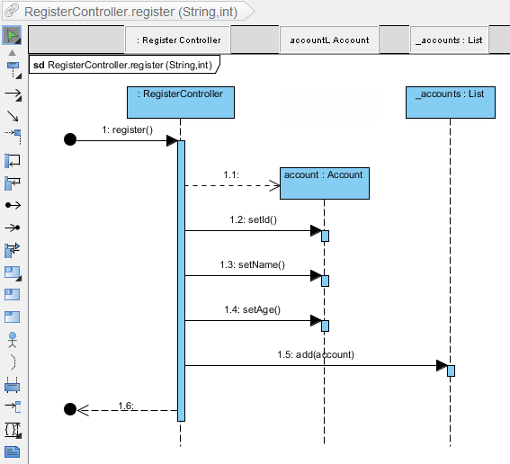

Create lifelines that represent the existence of an object or actor over time.In a sequence diagram, actors are represented by stick figures and objects are represented by rectangles.While creating a sequence diagram the first step is to identify all the objects that will participate in the system.It comes with specific shape libraries with sequence diagram notations and easy drag and drop functionality to visualize lifelines, actors and how they interact with each other. Creately’s sequence diagramming tool allows you to create detailed sequence diagrams.Sequence Diagrams are used to design, document, and validate the architecture, interface and logic of systems by describing the sequence of actions that need to be performed to complete a task. The State machine diagram below shows the basic states and actions.More Templates What Is a Sequence Diagram?Ī sequence diagram is a UML diagram type that represents how and in what order objects in a system interact with each other. These are very useful to describe the behavior of objects that act differently according to the state they are in at the moment. They are sometimes known as state diagrams or state chart diagrams as well. State machine diagrams are similar to activity diagrams, although notations and usage change a bit.

Click on the image to edit this template Get More Activity Diagram Templates > State Machine Diagram You can also refer this easy guide to activity diagrams. Check out this wiki article to learn about symbols and usage of activity diagrams. Sometimes activity diagrams are used as an alternative to State machine diagrams. They can be used to describe the business workflow or the operational workflow of any component in a system. Use Case Diagram Relationships Explained with examples Click on the image to edit this template Get More Use Case Diagram Examples > Activity DiagramĪctivity diagrams represent workflows in a graphical way. You can create use case diagrams using our tool and/or get started instantly using our use case templates. It’s a great starting point for any project discussion because you can easily identify the main actors involved and the main processes of the system. Check out this wiki article to learn more about the dependencies and elements found in package diagrams.Īs the most known diagram type of the behavioral UML types, Use case diagrams give a graphic overview of the actors involved in a system, different functions needed by those actors and how these different functions interact. Click on the image to use the object diagram as a template Get More Object Diagram Templates > Package DiagramĪs the name suggests, a package diagram shows the dependencies between different packages in a system. Because there is data available in the objects, they are used to explain complex relationships between objects. They show what a system will look like at a given time. Like class diagrams, they also show the relationship between objects but they use real-world examples. Object Diagrams, sometimes referred to as Instance diagrams are very similar to class diagrams. Click on the image to edit the deployment diagram above Get More Deployment Diagram Templates > Object Diagram
Sequence diagram generator for python software#
Deployment diagrams are useful when your software solution is deployed across multiple machines with each having a unique configuration.

Click on the image to edit the component diagram above Get More Component Diagram Templates > Deployment DiagramĪ deployment diagram shows the hardware of your system and the software in that hardware. The image below shows a component diagram.

The interfaces are linked using connectors. Components communicate with each other using interfaces. These are mostly used when working with complex systems with many components. Get More UML Class Diagram Examples > Component DiagramĪ component diagram displays the structural relationship of components of a software system.


 0 kommentar(er)
0 kommentar(er)
